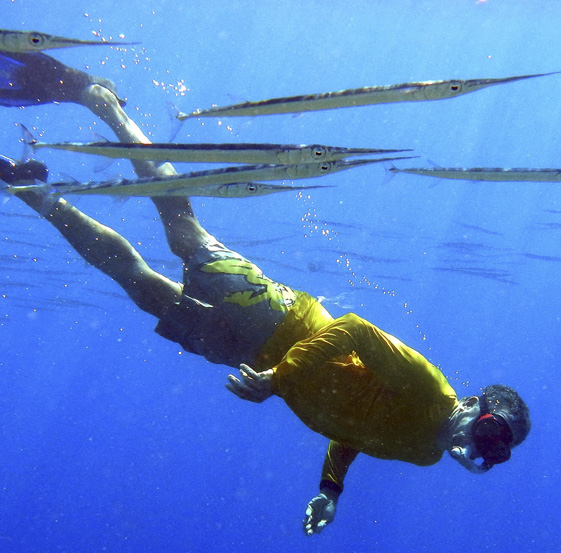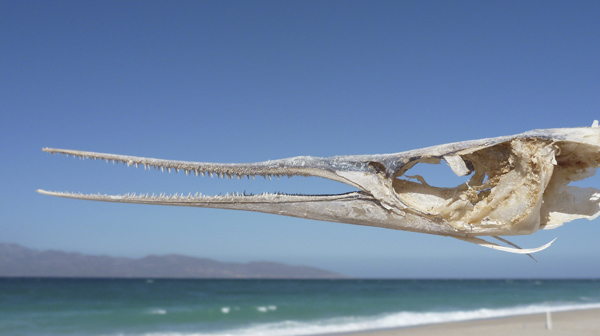Published in the Ocean Watch column, Honolulu Star-Advertiser © Susan Scott
July 28, 2014
Craig swimming with needlefish.
Big Island resident Michelle Chow emailed last week about an injury she suffered while surfing.
“I think I may have gotten in the way of a needlefish jumping out of the water,” Michelle wrote. “I would like to know what you think impaled my long finger.”
Michelle included a photo of the pieces the surgeon removed, and Craig (my ER doctor husband) and I agreed with Michelle. It looks like the beak of a speeding needlefish broke off in her finger.
 Craig swimming with needlefish
Craig swimming with needlefish
©2014 Susan Scott
Needlefish get their name from their long, pointed snouts fronting narrow, silver bodies. The fish never try to puncture people or anything else.
But when these lie-in-wait predators get startled by sudden movement during the day, or electric lights at night, they sometimes leap from, or rocket through, the water.
Depending on the size of the fish, this can be an impressive leap. Needlefish, close relatives of flying fish, have been clocked whizzing through the air at 37 mph. If you have the bad luck to be in the path of one of these fish missiles, you get speared.
Hawaii hosts four species of needlefish and two of their close cousins, the halfbeaks, fish with a stubby upper jaw but a long, spiky lower jaw. The fish are common in Hawaii, but because all swim just below the water’s surface, they’re easy to miss while snorkeling.
Depending on species, needlefish and halfbeaks range in size from 1 to 3 feet long. It’s often hard to tell the two kinds of fish apart. All look like sparkling spears, blue above, silver below.
Halfbeaks mostly eat seaweed, but needlefish eat fish. With a sideways lunge, needlefish snag passing prey with spiky teeth that line the upper and lower jaws.
Needlefish apparently taste good, but they aren’t a popular food fish because people find their bones an unappetizing color. For reasons unclear, needlefish bones are green.
I recently found two freshly dead needlefish heads on a North Shore beach, and the backbones sticking out were a lovely lime green.
Like flying fish, needlefish are common prey for fish predators such as tunas, jacks and barracudas.
Needlefish punctures are rare, but if you do get stabbed, see a doctor immediately. As in Michelle’s encounter with a bolting needlefish, beak fragments often break off in the wound, greatly increasing the risk of infection.
Getting banged by a blunt-nosed flying fish at high speed would be painful enough. But connecting with a needlefish gives a whole new meaning to getting needled.
 Needlefish. ©2014 Susan Scott
Needlefish. ©2014 Susan Scott